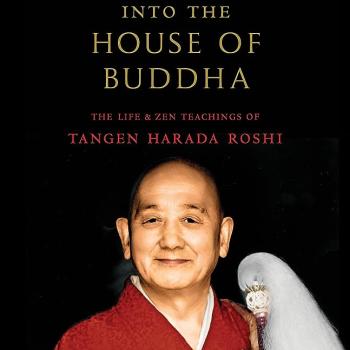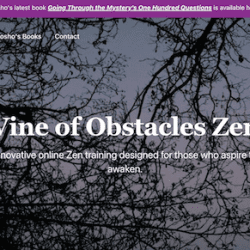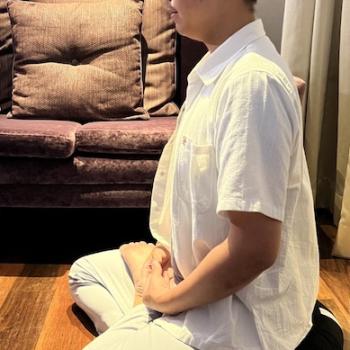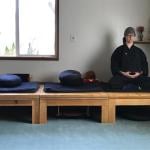There are no barbs in this old wire. Zen is really fishing without hook.
Speaking of which, it’s Day 2 of the current 100 days and here’s the first post on the Genjokoan. I’ll be posting a summary of the work from the Thursday night Genjokoan study group, usually on Fridays. During the next week, the local and virtual participants will post comments.
Last night we sat and then performed the memorial service for Katagiri Roshi. He died nineteen years ago on March 1 (see below for more on the ceremony). Then as usual we had tea, Shodo brought some spice cake, shared the offerings from the ceremony, and talked.
The first topic of conversation was about whether to record the sessions as some in the virtual practice have requested. The point of meeting and studying together, as well as listening to recordings of such discussions, imv, is to learn how to do dharma introspection and then hone our skills joyfully rolling with the dharma – alone and together.
We’re not so sure that our study sessions will help. It wouldn’t be like listening to a dharma talk, more like a conversation (wiggling around the sacred and mundane), so listeners might not find it very interesting. Also we apply (intwine) the dharma with our personal lives and talk about that. This is a direction we want to develop in our small group and are concerned that recording the sessions will damp that down or put more out there than we feel would be appropriate.
Almost everyone deferred to me (while stating their concerns). With my interest in post-modern power, I didn’t want to make this kind of decision and impose it on the group. So I decided to continue the conversation and consideration process. I’ll report more about this later.
Then we talked about practice commitments. We’re coming from almost three months “off” and so everybody seemed eager to ramp up the focus and time spent on formal practice. We’re also going to begin finding “capping phrases” to express our practice each week. The capping phrase is an aspect of koan practice. After a student has seen a koan, the traditional Rinzai Zen teacher will ask them to find a capping phrase to test and/or express their understanding.
In the Soto Zen
Genjokoan context, we’ll be using the capping phrase to express the student’s understanding of the issue at hand, the week’s practice. For example, one student last night brought this: “Put on your clothes, eat your food,” Zen Sand 4.394. Then students will be asked to present how that fits for their practice.Finally, we got around to working a little bit with
Genjokoan. We’re beginning with the second paragraph:“To convey the self toward the 10,000 dharmas to do practice/verification is illusion.
The 10,000 dharmas advancing and practicing/verifying through the self is satori.”
For now, I’m going to make three points on the translation and then the provide practice instructions and a focus for comments by participants. I’ll leave playing with the meaning of this passage to your own your discovery.
The above is my translation, based on an old character study that Roshi gave me long ago, informed by several modern translations. I see this as a practitioner’s translation, appropriate for those who want to take some time to work with Genjokoan close to the original bone and discover the meaning through the heart mind body in actual practice.
Second, I’ve also included the original “10,000 dharmas” rather than “all things” or “myriad dharmas” because, for me, the number suggests each thing , each of the many things, as truth. “All things” is just too mushy to convey the spirit of Soto Zen.
Finally, a bit more about “sho” which I’ve translated as “verification” and is one of several words used in Zen to connote satori or enlightenment. Here’s
Hee-Jin Kim (p. 21):Sho
(which means “to prove,” “to bear witness to,” “to verify”) signifies the direct, personal verification of savific reality/truth through the body-mind (shinjin), one’s whole being. A crucially important point here is namely, “that which verifies” and “that which is verified” are inseparably intertwined via the body-mind…. Enlightenment (nonduality) makes it incumbent upon practitioners to put the unitive vision of all things into practice, in terms of duality of the revisioned world.










